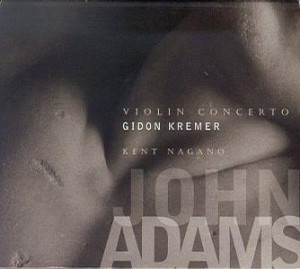John Adams, “Violin Concerto” and “Shaker Loops”
By admin_mike In
John Adams, Violin Concerto and Shaker Loops, released 1996 by Elektra Nonesuch Records
Violin Concerto (1993), performed by the London Symphony Orchestra; Kent Nagano, conductor; Gidon Kremer, violin
1. [Quarter note] = 78
2. Chaconne: Body through which the dream flows
3. Toccare
Shaker Loops (1977/83), performed by the Orchestra of St. Luke’s; John Adams, conductor
1. Shaking and Trembling
2. Hymning Slews
3. Loops and Verses
4. A Final Shaking
___
___
In music — and, I suppose, in general — I’ve always preferred altos to sopranos. While others seem to find it impressive, wailing away at the top of the musical range, whether it be a by vocalist or a violinist, is insipid and tiresome to my ear. Lots of swooping up and down just annoys me, coming off as a cheap attempt at introducing drama even when used by even my favorite composers. It’s the diva-prone roles I find least appealing. No, it’s the altos and basses, violas and cellos that really catch my ear. Hell, the lower and crunchier the better — I’ve even written a piece for double bass quartet…that perhaps someday I will find someone to play.
So I have an inherent dislike of the solo violin, and Adams’s Violin Concerto doesn’t really do anything to change my mind. The piece opens uncertainly, with the orchestra supporting the violin in an ambiguous harmony. And then they wander around for 15 minutes not really doing very much. And the violin just keeps going, no matter how much we (where by ‘we’, I mean ‘I’) want it to take a break. I’ve tried to pay more attention to what happens but just get too bored.
The same is true of the second movement, “Chaconne”; a musical form in which a harmonic progression is repeated, supporting a series of variations. It’s just that not much variation seems to happen. The damn violin keeps playing a melody which I find dull rather than expressive, occasionally joined by other instruments, but I just can’t care. Body through which the dream flows is a nice title, though.
Finally, in “Toccare”, something interesting and engaging happens. After two movements in which the violin just kind of flutters and floats around being pretty and NEVER STOPS, it takes on a much more rhythmic and energetic role…more as a fiddle than a violin, really. Probably in rondo-variation form, it’s catchy and fun, and at least partly makes up for the two movements that preceded it. It’s certainly enjoyable on its own, and I usually just start listening to the CD with this track.
***
Shaker Loops, one of Adams’s seminal pieces, is much, much better. Originally for septet, this arrangement for string orchestra was written in 1983. True to its title, it is composed of small, intertwining loops. Adams, though, is much less rigid about his structures than Glass and Reich, and takes a much more fluid approach to structure and harmony — a characteristic of his style that is now writ large.
Part one, “Shaking and Trembling”, opens with a quiet, constant, fast sixteenth-note pulse in the violins, over which the other strings slowly build…if not a melody…a figure. The music grows, builds, and develops, but the opening pulse is always present. Listening to it is like flying just above the ground. Or maybe just above the ocean, passing over waves that are all the same, yet each subtly different, slowly changing over time — and occasionally, a big wave will pass by that changes the whole texture. The music suddenly stops, as harmonics float above the suddenly placid surface before things begin to accelerate again. But the energy begins to dissipate, and the stillness of that quiet moment forms the basis of
“Hymning Slews” in which whispered, delicate notes emerge and disappear into a soft, lush environment. It’s a lovely, excellent contrast to the restlessness of Shaking and Trembling, which leads into
“Loops and Verses” as a beautiful and simple solo cello melody provides one of the first focal points in the entire work. Spurred on, the rest of the strings begin to resume the nonstop shuddering of Part one, over which the cello grows more searching and insistent, and is joined by another cello, which plays a similar line as the first but out of phase in a gorgeous counterpoint. The solo is taken over by a viola as the cellos are subsumed into the rest of the orchestra, but all eventually combine to recall the opening, though much more forcefully. As in the opening, a figure begins to form above the other instruments…but this time, it takes over, until all the strings start stomping around, hammering on every quarter note. Things calm down as they subside into a more rocking motion, eventually quieting down to the etheral sound of harmonics while still maintaining the quarter-note pulse, and the harmonics bring us into
“A Final Shaking”, which begins by referencing both the opening and the languid figures of Hymning Slews before building again into the fast, relentless pulse that’s the backbone of this piece. While there isn’t as much motivic variation in this movement, the music is pushed forward by a procession of dynamic swells until the texture begins to thin out, and the music fades away into nothingness, leaving you feeling weightless.
Holy crap, this piece is intimidatingly great. It’s one of the best examples of the what minimalism can accomplish when combined with a strong sense of musical narrative.


No Comment
Sorry, the comment form is closed at this time.